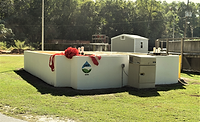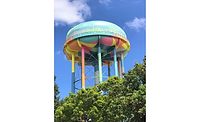Sherwin-Williams Announces Water and Wastewater Impact Award Winners

Image courtesy of Sherwin-Williams.
Top honors in the 2022 Sherwin-Williams Impact Award program went to a project relining a half-century-old penstock that will double the life of this critical piece of infrastructure that contributes to the production of clean energy at the Don Pedro Dam in Northern California. The Impact Awards recognize exceptional projects that feature high-performance coating and lining materials from Sherwin-Williams Protective & Marine.
The winning project featured a brave crew of applicators and engineers from coating and specialty contractor F.D. Thomas. Facing difficult conditions, lead containment needs and steep inclines, the crew relined the 16.5-foot-diameter penstock – with some portions installed at a 53-degree angle. The Don Pedro dam, power plant and reservoir are owned and operated by the Turlock and Modesto Irrigation Districts. Bay Area Coating Consultants, Inc. provided inspection services for the project.
The runner-up project for the 2022 awards went to a collaborative project between two public water and wastewater utilities that installed a mile-long water main through a tunnel bored under the Ben Sawyer Intracoastal Waterway in South Carolina’s low country. Conducted by Mount Pleasant Waterworks, Charleston Water System and others, the project fortified and added redundancy, pressure and quality to the water network of a coastal area with a growing population. More than 5,000 linear feet of steel pipe coated with cross-linked layers of a fusion-bonded epoxy and abrasion resistant overcoat was inserted underground at a maximum depth of 90 feet under a marshy wetland. MCIP Industrial Enterprises Corp. coated the pipe, with Quality Enterprises USA, Inc. performing the installation under engineering supervision provided by Hussey Gay Bell.
The 2022 honorable mention project provides insight into how water tank interiors can be recoated to comply with new national potable water standards. Looking to extend the life of the Norma Marshall Reservoir, a nearly 40-year-old, 4.8-million-gallon aboveground steel reservoir, Rancho California Water District officials in southern California opted for a 100% solids epoxy system to replace existing polyurethane- and epoxy-based linings. Industrial and maintenance services provider Advanced Industrial Services, Inc. performed the lining restoration.
“We are proud to showcase these exceptional projects that help ensure access to clean water and the safe disposal of wastewater,” said Paul Trautmann, Marketing Director, Water and Wastewater, Sherwin-Williams Protective & Marine. “The Sherwin-Williams Impact Awards exemplify how such projects demonstrate the significant efforts and unwavering commitment of our teams across the U.S. Their creativity and dedication – and their productive relationships with contractors, specifiers and asset owners – help improve public safety and extend the lifespan of infrastructure every day and for years to come.”
The Sherwin-Williams Impact Award program recognizes application contractors, specifiers and owners for excellence on North American water and wastewater projects that have a compelling effect on the industry with regard to public safety, asset protection and infrastructure life cycle improvement. Eligible projects included any water-related structure that was new, restored and/or rehabilitated in 2021 and was completed using coating and lining materials from Sherwin-Williams Protective & Marine.
A panel of esteemed experts from the water industry independently selected the winners for the 2022 Impact Awards. The judges evaluated entries based on various factors, including the complexity of the project, the obstacles surmounted by the participants, the solutions presented to the owner, the level of satisfaction achieved by all parties involved, and the project’s overall uniqueness.
First Place: Penstock Relining Adds Second Lifetime to Don Pedro Power Plant

Tucked inside a 16.5-foot-diameter enclosed pipe 300 feet below ground, a brave crew of applicators and engineers faced difficult conditions – from lead containment protection measures to steep inclines – to reline a 50-year-old penstock for the Turlock and Modesto Irrigation Districts (TID and MID). Their valiant effort will enable the penstock to operate reliably for another 50 years, doubling the life of this crucial element of the Don Pedro Dam and enabling the dam’s hydroelectric power plant to continue serving Northern California’s carbon-free clean energy needs.
The challenging project required a contractor team that wasn’t afraid of working inside a nearly quarter-mile length of steel-lined penstock with a 53-degree angle drop midway in the system. This configuration would require special rigging so workers could perform activities from a suspended scaffolding system. The crew would also have brief working windows of just 45 days each over two calendar years to rehabilitate 1,300 feet of pipe, including removing a thick coal tar epoxy with a red lead-based primer from every square inch of the pipe walls and then prepping, cleaning and relining the structure.
Few contractors are up to this sort of challenge. In fact, the owners of the Don Pedro Project sought proposals from 15 heavy industry coating contractors but received just one bid – from coating and specialty contractor F.D. Thomas (FDT). Accepting this challenge earned the FDT crew the nickname of the “Ameri-Cans” – because they “can” do the job when no one else wanted to try. This can-do attitude resulted in a newly relined and restored penstock featuring a durable epoxy lining that’s expected to double the penstock’s service life to at least 100 years.
At 580 feet tall, the Don Pedro Dam is the tenth highest dam in California. Its height and water feedstock layout created an especially difficult scenario for FDT’s engineering and application team to overcome. While the entire project entailed 1,300 feet of pipe, approximately 200 feet was installed at a drastic 53-degree angle. This incline necessitated some practice and procedural alterations on FDT’s end between the first and second years of the project.
During the project’s first 45-day stretch in 2020, FDT completed about 500 feet of the penstock relining in a barely sloped section of pipe. Various obstacles, including access needs and water infiltration, caused some delays. However, FDT was able to progress rapidly thereafter, with most of the surface preparation and coating application activities performed using automated equipment. This equipment was also used in 2021 to complete the remaining 375 feet of straight pipe before the steeply inclined section, as well as about 225 feet of pipe downstream from the incline.
With the entire relining project taking place within a confined space, FDT had to set up various air quality, dehumidification and temperature control equipment to condition sections of bulkheaded penstock. In addition, the contractor needed to contain lead when removing the previous lining. Crewmembers used robotic and manual blasting methods to remove the old lining and any other residues from the pipe walls, collecting, sorting and disposing the lead-contaminated debris along the way.
Anticipating another 50 years of service life for the restored penstock, TID and MID specified the use of a durable ultra-high-solids epoxy amine lining, Sherwin-Williams Sherplate™ PW epoxy. The coating has a high film-build capability, as well as high edge-retention capabilities, enabling it to be used for stripe coating welds, edges and corners before completing full lining applications. In addition, it contains no solvents, which was critical for maintaining air quality in the pipe and meeting confined space entry requirements for the job.
Applicators were able to spray-apply the lining in one pass, building the coating to a minimum thickness of 30 mils dry film thickness (DFT) to ensure long-term protection. Touchup needs were minor following inspection via holiday spark testing, but they were especially easy to manage given the Sherplate PW product’s 14-day recoat window. In addition, the lining material’s 24-hour return to service time helped the team by enabling them to work right up to the end of each 45-day window each year to complete all the necessary activities.
Runner-Up: Going Down Under: Installing a New Water Main Below the Intracoastal Waterway

To install a nearly mile-long new water transmission line linking the Charleston Water System’s existing line on Sullivan’s Island to a nearby Mount Pleasant Waterworks-owned water main, the project team had a big obstacle in their way – the Ben Sawyer Intracoastal Waterway. Adding this critical piece of infrastructure under the environmentally sensitive habitat along the coast of South Carolina required extreme care to protect both the environment from harm and the pipe itself from damage during installation and operation.
Environmental considerations and obstacles limited the use of heavy equipment in the protected wetland and eliminated the option of placing the pipeline in an open trench that would be backfilled. Instead, contractors from Quality Enterprises USA, Inc. used horizontal directional drilling (HDD), also known as directional boring, to bore under the waterway and pull the pre-assembled pipe through. Hussey Gay Bell provided engineering support for the project.
At a maximum depth of 90 feet, the bored tunnel required more than 5,000 linear feet of pipe to traverse the waterway. In total, the project included around 430 linear feet of 16-inch ductile iron pipe (DIP), 92 linear feet of 12-inch DIP, and 5,180 linear feet of 18-inch steel water main. The project team needed an exterior coating system for the steel pipe that would protect against corrosion, that could handle the harsh environment inherent to underground service – and that could be trusted to remain effective despite incurring inevitable damage while the pipe was pulled through the nearly-mile-long hole. The coatings also needed to offer flexibility for the pipe installation, while not cracking or allowing the penetration of moisture.
To prepare the pipes for coating applications, industrial contractor MCIP Industrial Enterprises Corp. used an SSPC SP-10 blast on both the inside (ID) and outside diameter (OD) of each pipe. Next, applicators moved each pipe into the application booth to be coated inside and out.
For the interior coating, MCIP applied Sherplate™ PW liquid epoxy, a 100% solids epoxy that met the minimum 25-mil DFT requirements in a single pass, using automated sprayers. The ultra-high solids epoxy amine coating is engineered for immersion service in potable water pipes and provides superior protection.
The exterior of the pipes received a near simultaneous spray of 20 mils dry film thickness (DFT) of PipeClad® 2000 FBE (Fusion-Bonded Epoxy) coating, followed immediately by a 40-mil DFT coat of PipeClad 2040 Flex ARO (Abrasion Resistant Overcoat). The rapid succession of the coating applications helped to create a stronger interlocking bond between the two layers. The dual-layer powder system provided extremely robust protective coatings to the outside of pipes to stave off corrosion and prevent damage through storage, transit, construction and service.
As part of the project’s phased implementation, the water main was staged and welded along a municipal road, before placing the entire line underground. For the exterior girth welds, the installation crew applied 60 mils of PipeClad 5000 liquid epoxy by brush and roller. Quick-drying and offering a fast return to service and excellent adhesion to prepared steel, PipeClad 5000 is a two-component, ultra-high solids, amine-cured epoxy, engineered specifically to deliver long-term corrosion resistance, as well as high-impact and abrasion resistance and temperature resistance to below-grade underground utilities and other infrastructure.
The interior girth welds received 25 mils DFT of Sherplate PW liquid epoxy. Applicators used a remote blast head to first clean the interior welds and hold back areas, followed by using a remote sprayer to line these areas. As a user- and application-friendly epoxy, Sherplate PW helped applicator achieve a high-quality finish in a single coat – offering efficiency and time and cost savings.
The bored hole provided a harsh environment for a coating, which needed to stand up to scouring as the pipe slid past sharp rocks and earth along its nearly mile-long journey under the Ben Sawyer Intracoastal Waterway. Knowing that some damage to coatings was unavoidable, engineers paid close attention to how the coatings system would work in conjunction with a cathodic protection system, which would provide supplemental electrical corrosion control. The $8.5 million 10-month project was completed on budget and on time – and an extensive restoration effort added new landscaping and streetscaping features.
Honorable Mention: The Future of Water Tank Interiors: The Recoating of the Norma Marshall Reservoir

The refurbishment of the Rancho California Water District’s Normal Marshall Reservoir in southern California provides a glimpse into the future of interior water tank linings. While the interior roofs and rafters of most ground storage reservoir tanks are coated with multi-coat systems, the tank’s owner saw the value in using Sherplate™ PW, a 100% solids epoxy that can be applied in one high-build coat, for the entire interior of the tank to extend its service life. The material will provide corrosion resistance for critical areas of the nearly 40-year-old 4.8-million-gallon aboveground welded steel tank. The epoxy was chosen for the increased edge retention – and excellent single-coat coverage of edges, corners, angles, bolts and other components – it would provide for the reservoir, which is 164 feet in diameter, with a 34-foot shell height.
The four-month project, completed in mid-2021, brought the tank into compliance with new NSF/ANSI/CAN 600 standards for potable water, which took effect in January 2023 – nearly a year and a half early. These standards also contributed to the choice of Sherplate PW, instead of traditional solvent-rich epoxies, which would likely require two thin coats and take longer to cure. In most areas of the Norma Marshall Reservoir, applicators were able to apply the high-build coating thicker in a single coat.
Constructed in 1982, the welded steel ground storage reservoir had last been recoated in 2008 using a unique hybrid 100% solids elastomeric polyurethane system for the roof and rafters, with an epoxy on the bottom plate and floor. The district had faced issues of delamination, blistering and deterioration of the coatings, particularly the polyurethane, which compromised the integrity and, potentially, the longevity of the steel tank. Removing old coatings from the roof proved challenging, leading Bakersfield, California-based contractor Advanced Industrial Services, Inc. to use air-powered chippers to get under the coating and remove it. Using recyclable abrasive steel grit 25, crewmembers next dry blasted all interior tank surfaces to the SSPC-SP 10 standard – leaving the surface free of coatings and residues with a minimum 2-mil profile to promote adhesion.
Applicators next brushed a stripe coat of Dura-Plate® UHS Primer, at 4 to 8 mils DFT, onto all weld seams, edges, angles, bolts and other critical areas. A two-component, ultra-high-solids epoxy amine, the primer offered ease of application and provided excellent surface wetting and adhesion properties, especially over rust pitted steel surfaces. It is recommended for immersion service in a variety of tanks.
All interior reservoir surfaces – including the roof, shell and floor, with edges, nuts, bolts, welds, joints and similar connections – were sprayed with a topcoat of Sherplate PW, a two-component, edge-retentive, low volatile organic compound (VOC)-rated, low odor, ultra-high-solids epoxy amine coating. The Sherplate PW coating system was designed to control corrosion in the vapor space above the water line and the structural steel of the roof, including beams, as well as protect the remainder of the immersed tank.
Crewmembers applied two coats to the roof and rafters for added protection and one coat to the floor and shell, with each coat applied at a thickness of 24 to 36 mils DFT. Engineered for immersion service in potable water pipes and storage tanks, Sherplate PW provides superior protection thanks to its high-build properties and its greater than 70% edge retention. Due to the notorious challenges in measuring or inspecting coating thickness in the tank’s roof and rafter areas, the applicators confidently applied coatings to these sections. This ensured the tank’s long-lasting durability and uninterrupted service, greatly benefiting the Rancho California Water District and its patrons.
Unanticipated issues arose concerning the tank’s support system. After noticing the deterioration of metal caused by the blasting process, the project team was required to carry out extensive repairs. This involved replacing the central vent and seven rafters. Additionally, the team tackled the challenge of addressing approximately 60 rafter-to-shell clips by equipping them with fresh nuts and bolts. Furthermore, they installed an entirely new collection of earthquake rods to enhance the strength of the mid-span bracing.
The tank also required the protection of an intricate system of internal piping that needed additional care during surface preparation and the application of coatings. Before beginning interior blasting, contractors used small mobile cranes to remove the interior mixing system’s piping. They then cleaned, prepared and coated those components outside the tank before reinstalling them.
During multiple visits, Sherwin-Williams Protective & Marine tech reps assisted the application crew with setting up two plural component pumps on-ratio, which ran concurrently, using transfer pumps to pull the coatings directly from the drums. The setup allowed applicators, using scaffolding, to reach the tank’s upper nooks and crannies with ease. Tech reps also provided consumables, including spray tips and housings, for the project – and instructed water district personnel on the ease of repairing any nicks or damages to the coatings. An owner-led inspection confirmed the thickness of the coatings, passing with flying colors – and found only three holidays.
*All images courtesy of Sherwin-Williams.
Looking for a reprint of this article?
From high-res PDFs to custom plaques, order your copy today!







